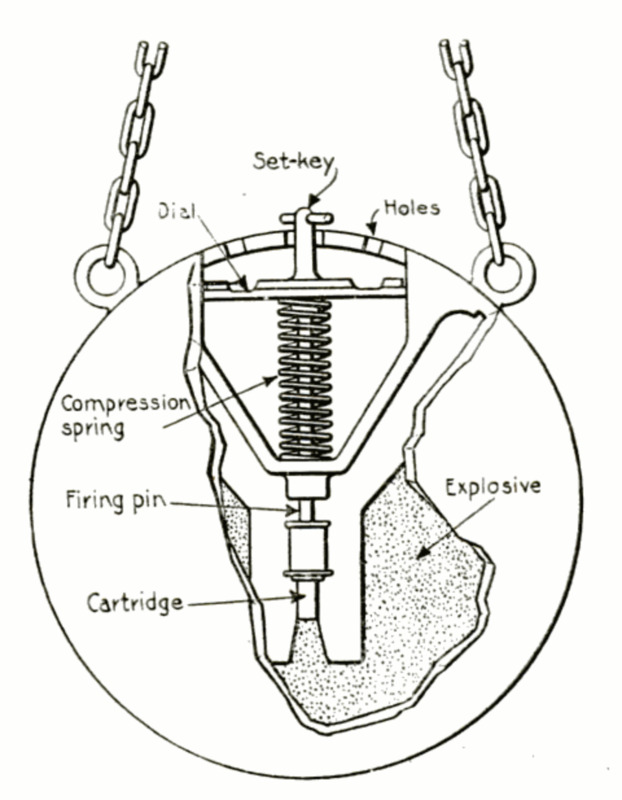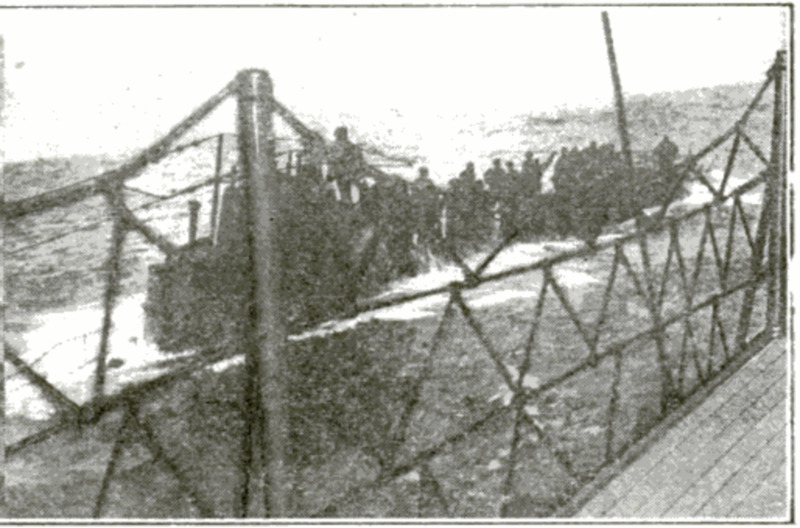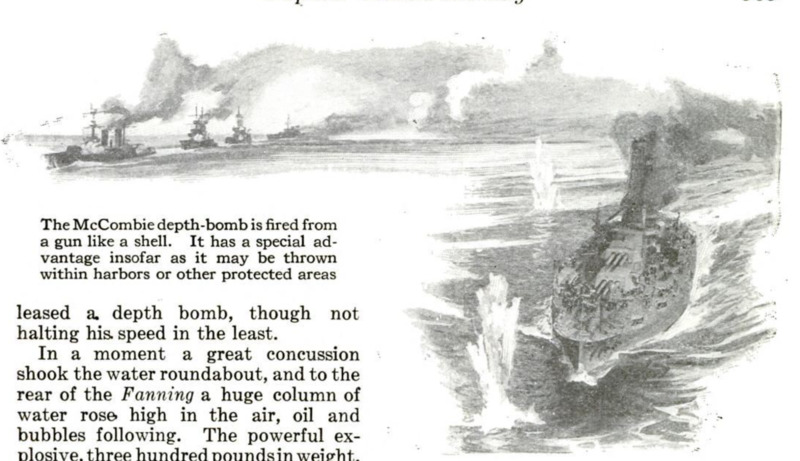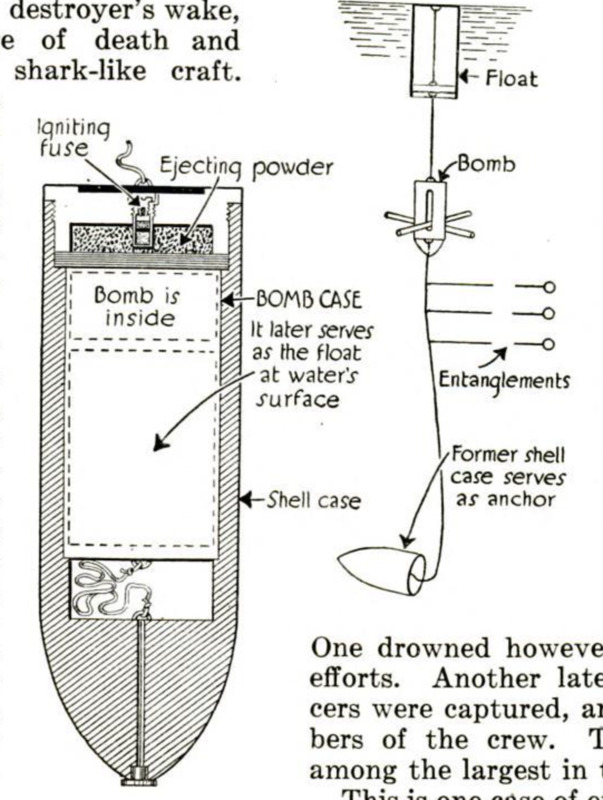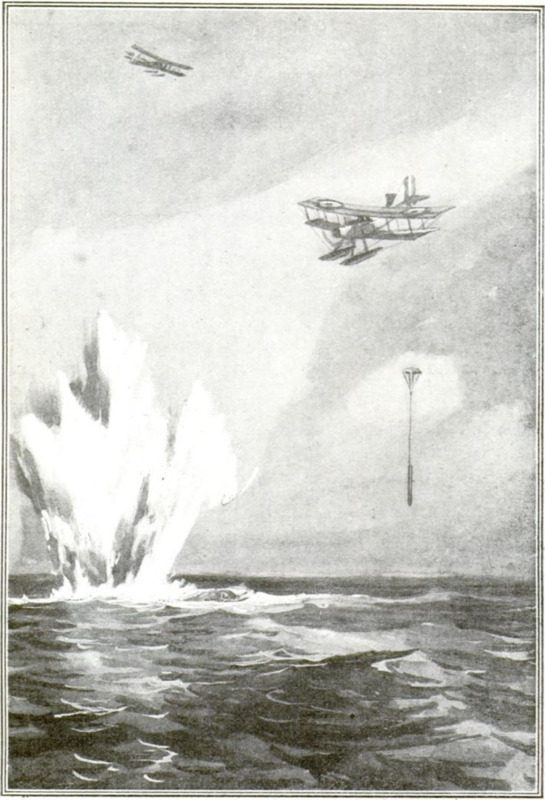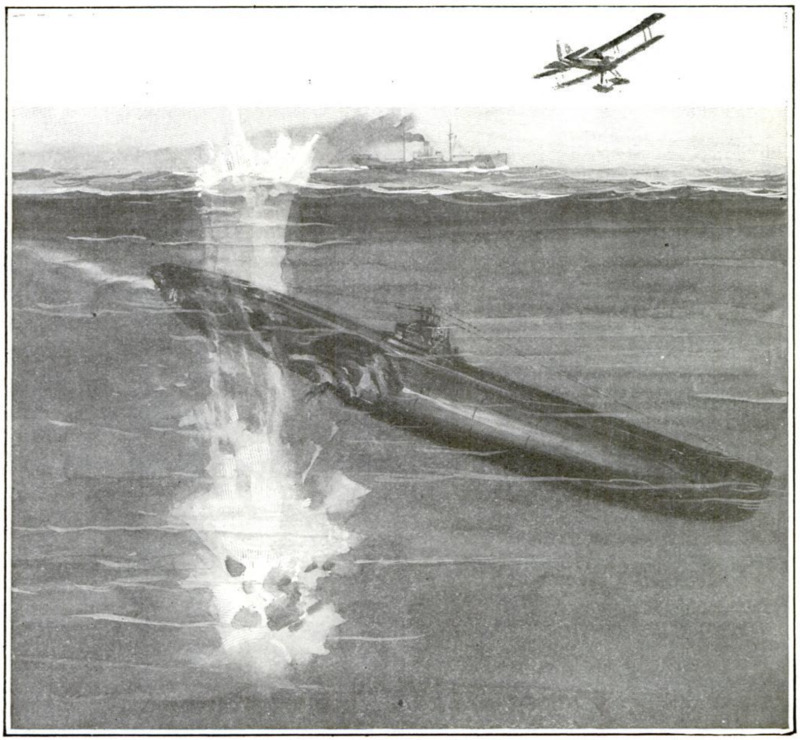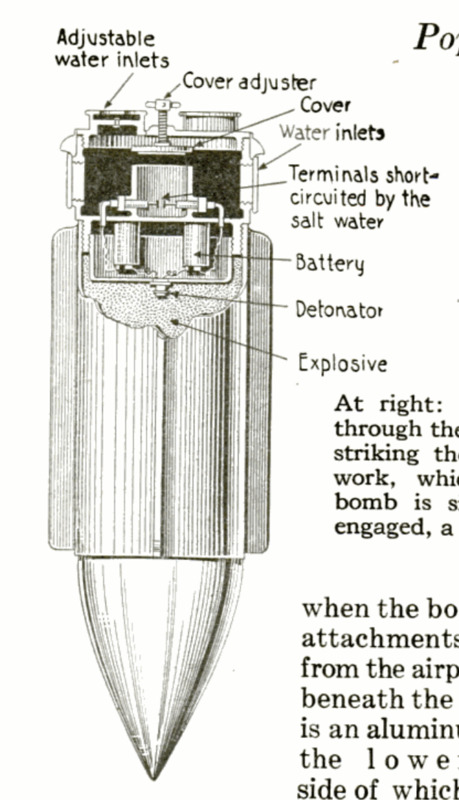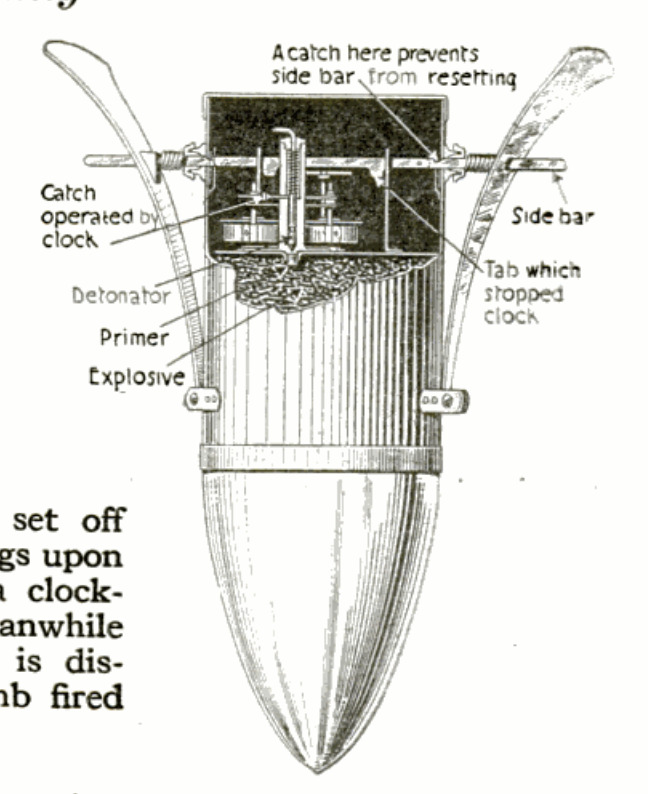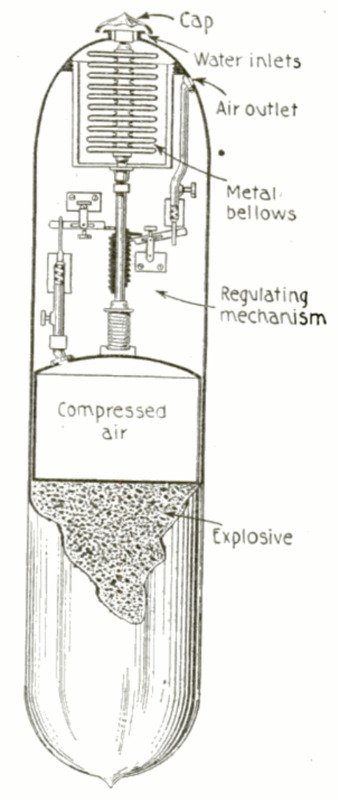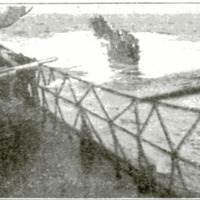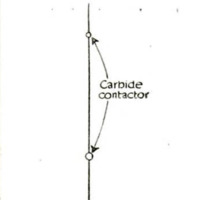-
Title (Dublin Core)
-
Depth-Bombs
-
Article Title and/or Image Caption (Dublin Core)
-
Dealing Death with Depth-Bombs. How depth-bombs and new sea tactics are foiling the submarines
-
extracted text (Extract Text)
-
WHAT is the reason subi. arines
have occupied less and less of the
limelight recently? How does it
happen that their ferocity has proven not
so unconquerable as at first thought?
It’s a good old American reason—pluck
and inventive genius.
We should an-
nounce at the begin-
ning that the tactics
of American de-
stroyers operating in
the submarine zone
are just the opposite
of what has been cur-
rent practice. Every
time our destroyers
see a submarine, they
head straight for it.
The old idea was to
circle around and take
pot shots every time
opportunity offered.
The new idea works
havoe with the plans of
underwater plotters.
But suppose our
destroyers do head
straight for the sub-
marines —how do they
do any exterminating
even then? Answer:
Depth-bombs.
Let us pause for a
moment and consider how two American
destroyers, the Fanning and the Nichol-
son, recently disposed of a U-boat with
depth-bombs. The incident, as vari-
ously reported in the Associated Press
despatches, was exciting. We may retell
it as follows:
Wherein One Sub-
marine Succumbs
“Periscope two
points off the star-
board bow!" called a
lookout on the Fan-
ning. Instantly an
alarm to general head-
quarters was sounded
and the helm thrown
hard over. Signal
flags were swung out,
notifying the sister
ship of the exact loca-
tion of the enemy.
At the same time the
heliograph began its
staccato flashing of
orders for a combined
attack.
‘The submarine sub-
merged. Straight for
the spot where last it
was seen went the
Fanning. Arriving,
the commander re-
leased a depth bomb, though not
halting his speed in the least.
In a moment a great concussion
shook the water roundabout, and to the
rear of the Fanning a huge column of
water rose high in the air, oil and
bubbles following. The powerful ex-
plosive, three hundred poundsin weight,
and in a steel case, had sunk with a
little splash into the destroyer’s wake,
bringing its message of death and
destruction to the shark-like craft.
Meanwhile the
Nicholson had ar-
rived on the scene,
and it too dropped a
depth-bomb. Then
both boats began cir-
cling the area wait-
ing developments.
Inside three min-
utes developments
came. With a splash
of water the sub-
marine suddenly ap-
peared on the sur-
face, like a great
whale coming up to
breathe. It behaved
erratically; was evi-
dently unmanage-
able. The Fanning
again bore down, fir-
ing from the bow
gun. The Nicholson
also closed in. But
only a few shots were necessary. Out
piled the entire German crew, holding up
their hands in token of surrender. Before
they could all be transferred the U-boat
sank from under them, never to return.
Some of the American crew jumped into
the water in an attempt to save stragglers.
One drowned however, in spite of these
efforts. Another later died. Four offi-
cers were captured, and thirty-five mem-
bers of the crew. The submarine was
among the largest in the Germany navy.
This is one case of effective work on the
part of depth-bombs, and of American sea
strategy. It is typical.
Depth-Bombs Are of Many Kinds
What are depth-bombs? Trinitrotoluol
or other high explosive in a container.
Detonated under water, they cause a
violent compressive wave to go out,
caving in the side of a submarine in the
vicinity as if it were an eggshell.
According to Edward F. Chandler, a
New York expert on underwater develop-
ments, one type of effective depth-bomb
depends solely on water pressure for
explosion. The illustration on the right
shows details.
The bomb may be of any convenient
exterior shape, and is customarily
equipped with two eyes for the attach-
ment of supporting chains at the stern of a
destroyer, or other convenient point. The
underwater pressure acts simply. Push-
ing in on the diaphragm shown, it causes
a detonator to be fired and the explosive
set off. The particular depth at which
detonation occurs may previously be fixed
by adjusting the bolt which projects
through the diaphragm and outer shell of
the bomb. A graduated scale reading
in feet makes this easy. The bolt tightens
up or slackens the coil-spring pushing
on the underside of the diaphragm,
thereby making a correspondingly greater
or lesser water pressure necessary to com-
press it and produce an explosion.
Evidently the type described by Mr.
Chandler is the result of evolution, and it
probably is the most effective yet de-
veloped. However, many other kinds
have been patented. A Virginia man
named Dunlop produced the one depicted
on page 566. This is exploded through
the driving in of a pair of wings upon the
bomb’s striking the water. These wings
release a suitable clockwork, which must
run a short time before the primer is set
off. Meanwhile the bomb is supposed to
be sinking as a result of its initial velocity
in striking the water. Whether or not it
would always do this, and whether the
complicated clock mechanism would al-
ways run properly is open to doubt. But
obviously a clockwork is one way of ex-
ploding a depth-bomb and probably many
working on the general principle are in
current use. None of the Allied govern-
ments will tell precise details of the latest
developments in depth-bombs, for the
Germans would be too interested. But
from a consideration of general types
already known in the depth-bomb field,
an idea of the underlying and fundamen-
tal principles may be obtained.
Airplanes Use Depth-Bomb
Not all depth-bombs are dropped by
destroyers. Airplanes have used them
with great success. On page 564 we show
a type produced by W. J. Hallock of
Jersey City. The explosive is contained
within a long, pointed cylinder at the
upper end of which is a detonator and a
small electric battery. An insulated
electric cable containing two wires is
attached to the upper part of the cylinder,
and leads to a relatively small parachute
which serves to straighten out the cable
when the bomb and its
attachments descend
from the airplane. Just
beneath the parachute
is an aluminum disk on
the lower
side of which
is mounted a flexible diaphragm.
When the diaphragm strikes
the water in trailing along after
the bomb at the end of the
cable, it is driven inward, and
causes an electric contact to be
made between the ends of the
wires coming up through the
cable, which, in turn, causes the
bomb’s explosion at a depth
below the surface determined by
the cable's length. Should this
impact contactor at the dia-
phragm fail to set off the bomb,
other pairs of contacts are pro-
vided at intervals along the ca-
bles length. These are separated
by pieces of calcium carbide, or
starch, and are suitably pro-
tected from mechanical injury.
The carbide or starch dissolves,
allowing the contacts to come
together and explode the bomb.
Another of Mr. Hal-
lock’sinventions isshown
above. This one is with-
out a parachute and ex-
plodes by the action of
salt water entering at the
sides and top of the up-
per end, and complet-
ing an electric circuit
through the pair of elec-
trodes shown. The depth at which
the bomb is to explode is regulated by
adjusting the size of the openings ad-
mitting water. The smaller the opening
the longer the bomb can descend as a result.
of its initial velocity be:
fore flying into atoms.
It is a curious fact, dis.
covered since the war be.
gan, that an airplane when
high in the air, can fre-
quently see a submarine
plainly, even though it be
submerged as much as one
hundred feet. Naturaliy
the depth varies with the
clearness of the water
in any given region, but
surprising results have
been attained. A sub-
marine is visible under
water from a height for
the same reason that a
nickel is visible in a pan of
water when your eve is
directly over it. Should
you get your eye off to one
side and almost tothe level
of the water in the pan,
refraction (light-bending)
effects would enter in,
as well as reflection of
other objects to your eye
from the water's surface.
In consequence you could
not see the nickel. It is
for the same reason that
one can rarely see the
bulk of a submarine un-
der water from the deck of a
ship, though it may be perfectly visible
from an airplane. The man on the deck
can see only reflections from the choppy
waves, He is too near the surface.
K. O. Leon, a Swede, has patented in
this country an unusual depth-bomb
mechanism. The sketch on page 566
gives details. The Government has ex-
perimented exten-
sively with this
type and its varia-
tions. The peculiar
feature about this
machine is that it
is designed to keep
a depth-bomb at a
certain _predeter-
mined depth be-
neath the surface,
to remain there
until contact with
an underwater
prowler sets it off.
A metal bellows
at the top of the
‘bomb is filled with
air and is sur-
rounded by sea-
water which enters
through the top-
most point of the
bomb's case. Nat-
urally, the pres-
sure which this
water is capable of
exerting varies
with the distance
the bomb happens
to be beneath the
surface. Mr. Leon has not disclosed in |
his patent the particular type of firing |
‘mechanism he uses with his bomb.
T. G. Fitz G. McCombie has invented a
type of depth-bomb to be fired from a gun. |
The bomb can thus be dropped among
enemy ships with the readiness of a shell, |
vet possesses the submerged exploding |
Teature so destructive to a ship's plates
beneath the water line. The figure on
page 563 shows details.
All reports from the zones where sub-
‘marines are operating indicate that depth-
hombs are almost the universal means of
going after and “getting” underwater
prowlers. While other means for extermi-
nating U-boats will be evolved during the |
war, few can be so simple and effective.
-
Contributor (Dublin Core)
-
Lloyd E. Darling (writer)
-
C. P. I. (photo)
-
Language (Dublin Core)
-
eng
-
Date Issued (Dublin Core)
-
1918-04
-
pages (Bibliographic Ontology)
-
562-567
-
Rights (Dublin Core)
-
Public Domain (Google digitized)
-
Archived by (Dublin Core)
-
Filippo Valle
-
Alberto Bordignon (Supervisor)
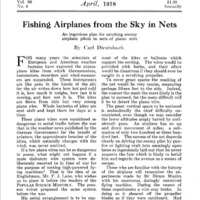 Popular Science Monthly, v. 92, n. 4, 1918
Popular Science Monthly, v. 92, n. 4, 1918

